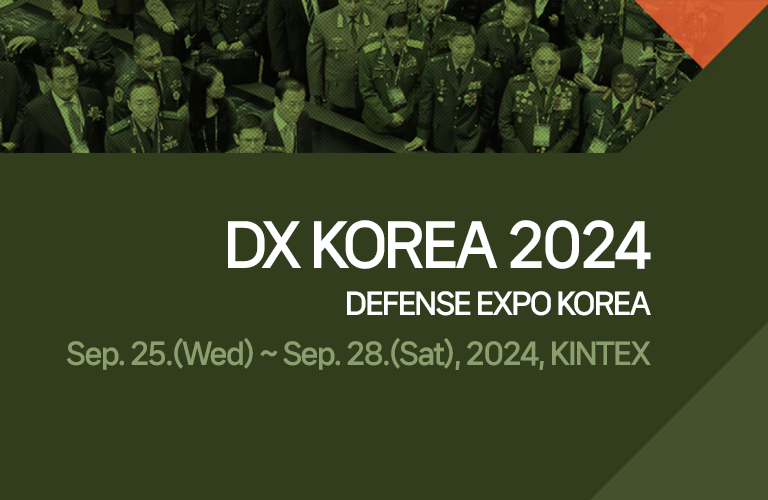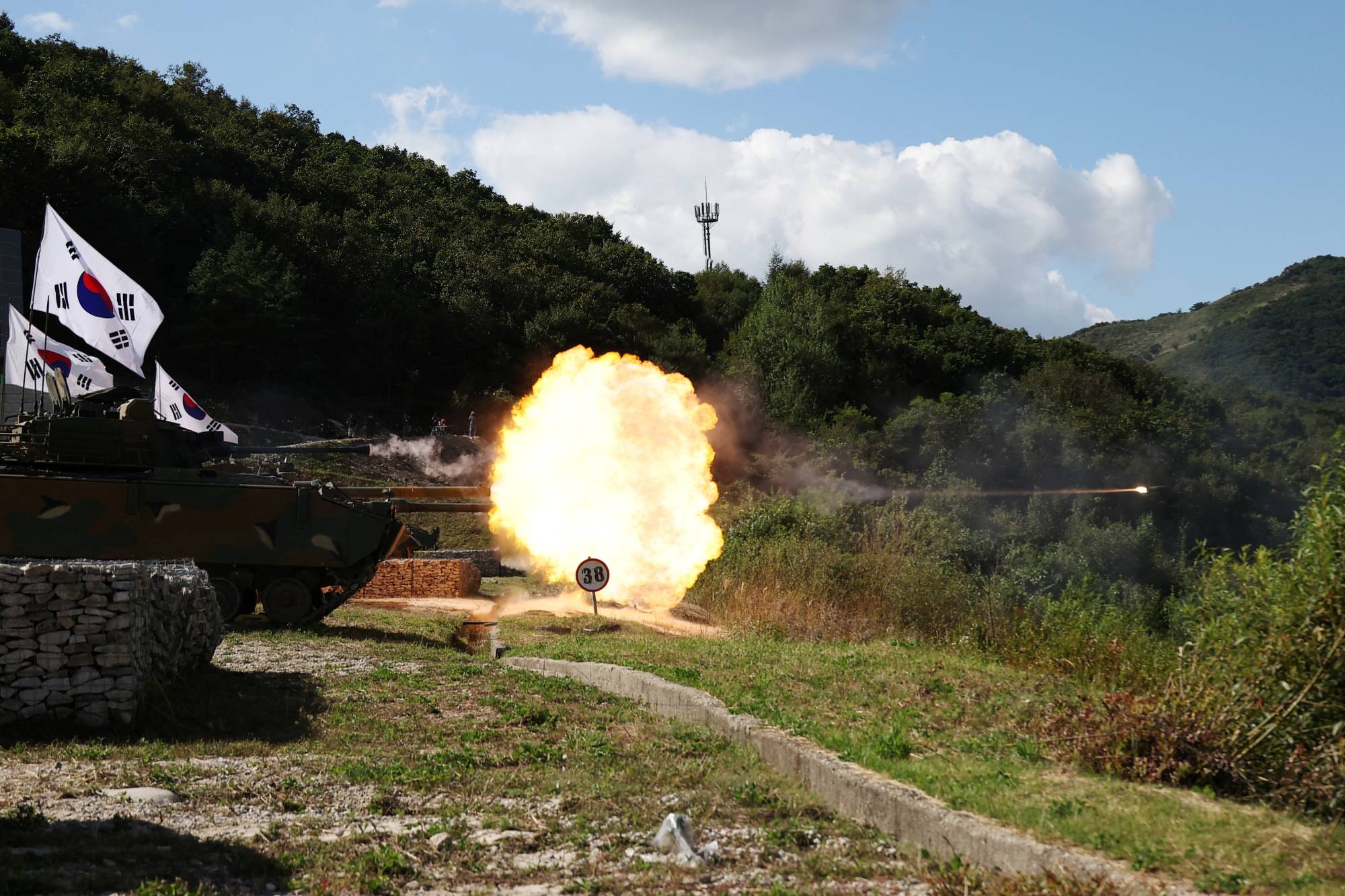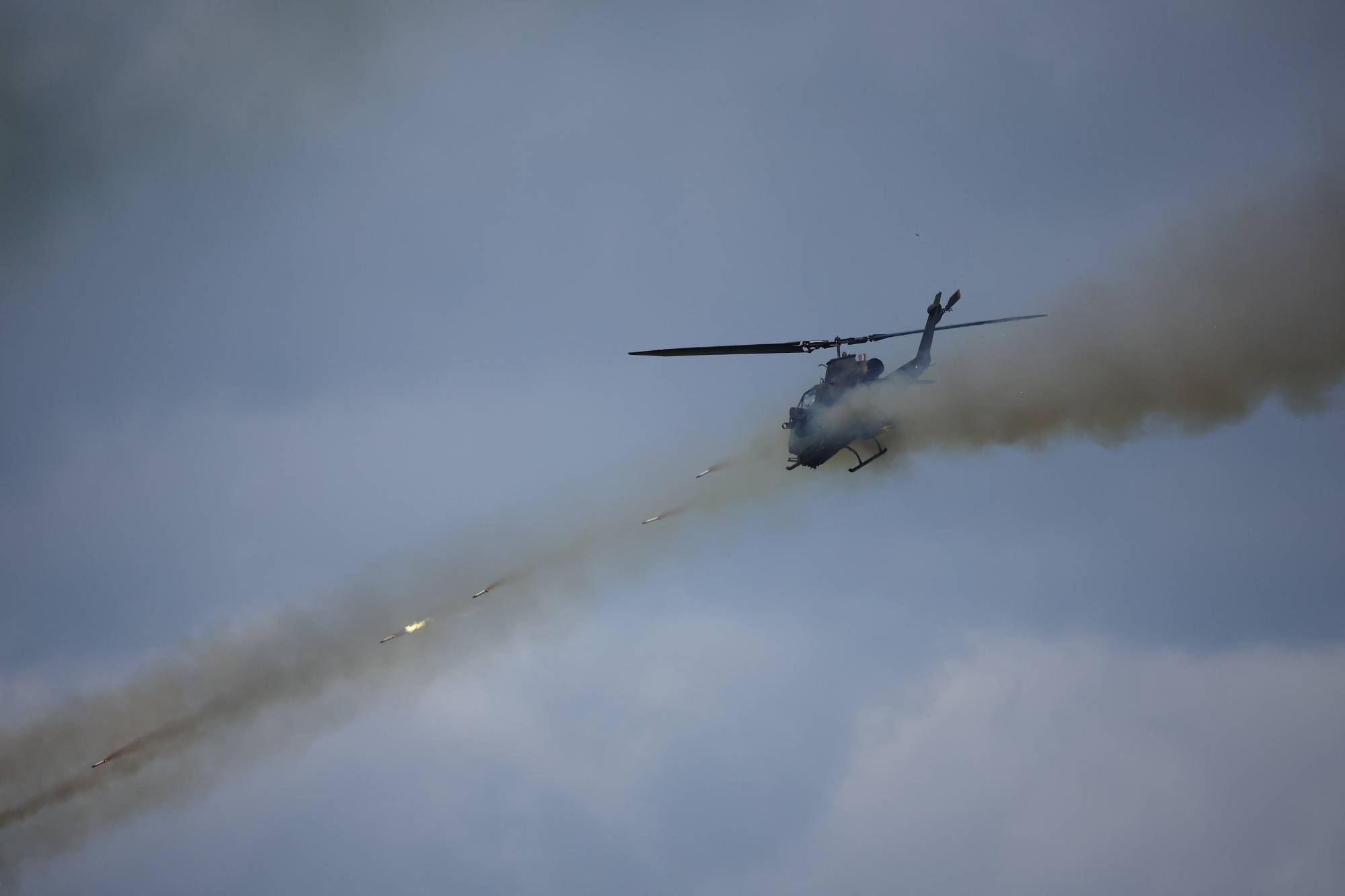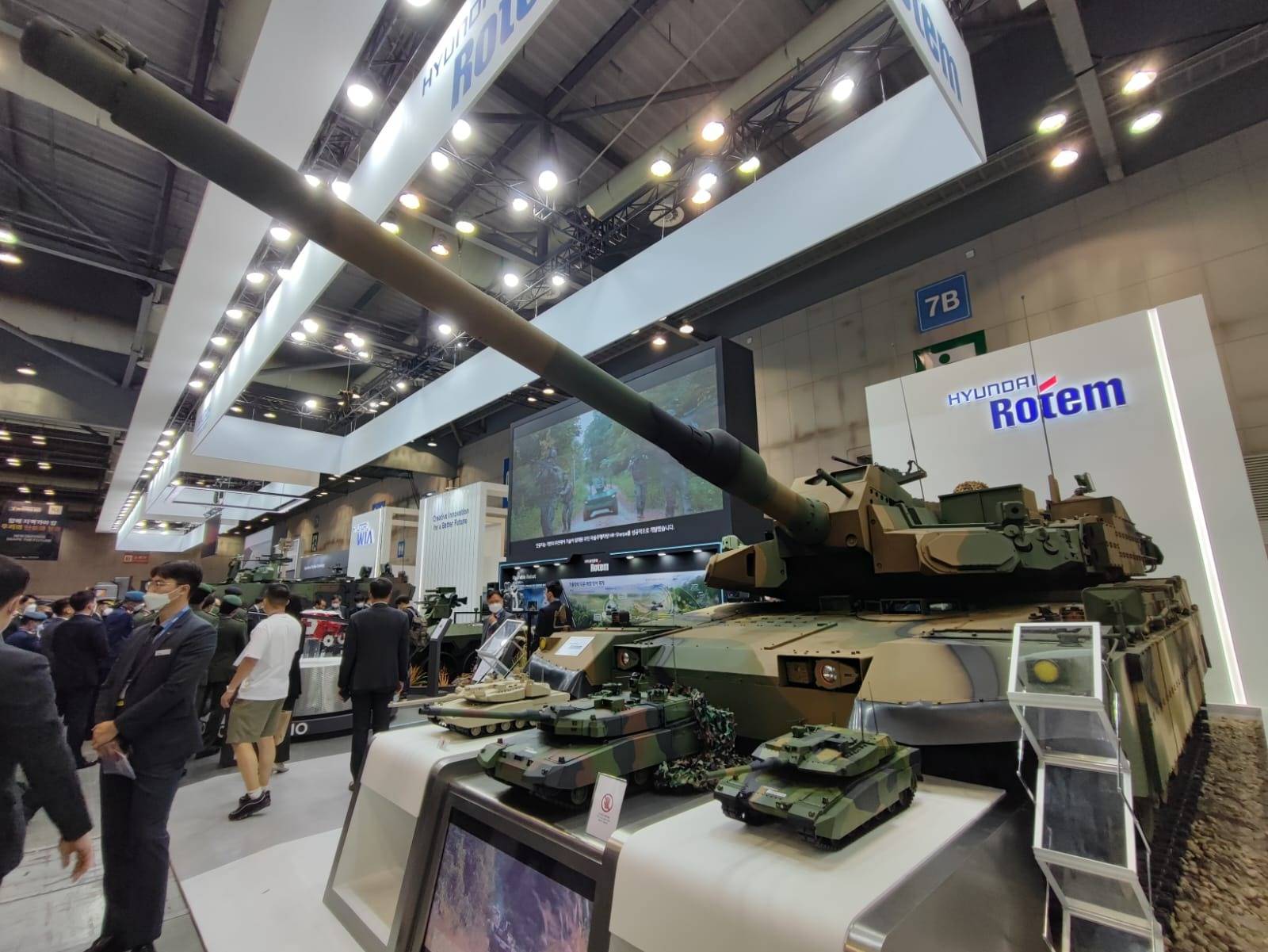

Media Center
Industry News
| Title | South Korea emerges as major defense industry player | ||
|---|---|---|---|
| Date | 2022.09.29 | Hit | 1913 |
|
A model of Korea Aerospace Industries' carrier-borne variant — called the KF-21N — of the KF-21 Boramae supersonic fighter aircraft. | GABRIEL DOMINGUEZ
GOYANG, SOUTH KOREA – As Japan’s defense industry struggles, South Korea’s is thriving, driven not only by the need to counter Pyongyang’s growing military threats but also by Seoul’s ambition to make the country one of the world’s top defense exporters. Just how determined the government is to help the industry expand was highlighted in recent statements made by President Yoon Suk-yeol, who last month expressed his intention to make his country one of the world’s top four weapons suppliers. “By entering the (list of the) world’s top four defense exporters after the United States, Russia and France, the defense industry will become a strategic industrialization and a defense powerhouse,” Yoon said. That may seem like a lofty goal for South Korea — which is currently the world’s eighth largest defense exporter — but recent deals have highlighted the country’s progress, with a growing number of nations turning to South Korea to meet their critical defense needs amid heightened concern over the war in Ukraine. “South Korean companies make no secrets of their aim to become major players on the global arms market,” said Siemon Wezeman, a senior researcher with the Stockholm International Peace Research Institute’s (SIPRI) Arms Transfers Program. “For many it is an important segment of their total market. In that respect they are very similar to the large U.S. and European arms producers.” One of the key features of Seoul’s plan involves the continued international promotion of the latest South Korean-made military equipment and technologies, including at exhibitions like DX Korea 2022, which took place last week in Goyang, near Seoul. Among the highlights of the five-day event were advanced air, land, unmanned and missile defense systems showcased by the country’s top defense companies. Korea Aerospace Industries (KAI), for instance, displayed a model of a carrier-borne variant — called KF-21N — of the KF-21 Boramae supersonic fighter aircraft it is developing for the South Korean Air Force. While there is currently no formal domestic requirement for the new variant, the aircraft could potentially be developed for export. It could also be offered for use by the South Korean Navy should Seoul approve the construction of a medium-sized aircraft carrier. The company also showcased a model of a new multirole transport aircraft called the MC-X.
A South Korean K2 tank takes part in a live-fire military exercise that was part of DX Korea 2022 in Pocheon, South Korea, on Sept. 20. | REUTERS
Meanwhile, Hanwha Systems unveiled a model of a vertical take-off and landing, electric-powered tilt-rotor aircraft called Butterfly that it is co-developing with U.S. company Overair. For its part, Korean Air, the country’s largest airline, displayed an array of multimission drone models, including the next-generation KUS-FC stealthy combat drone and the KUS-LW drone, the latter of which is designed to work together with manned aircraft. Korean Air says it plans to develop a system in which three to four KUS-LWs will not only support and escort a combat aircraft but also be able to perform their own missions, including reconnaissance, electronic warfare and precision-strike operations.
A broad range of products and marketsThe array of advanced platforms and systems on display at the exhibition not only highlights the technological edge South Korea has gained over its bellicose northern neighbor, but also the increased focus on exports by an industry that has been targeting every geographical market. According to data provided by SIPRI, South Korea only accounted for about 1% of global defense exports between 2012 and 2016, but that figure shot up to 2.8% in the following five-year period through 2021 thanks to a 177% increase in sales. That made Seoul the world’s eighth-largest defense exporter over that time frame. This was by far the largest increase in terms of market share for any of the world’s top 25 arms exporters, according to the data. A recently released report by the Export-Import Bank of Korea — one of several loan providers for South Korea’s Defense Acquisition Program Administration (DAPA) serving international customers — revealed that defense exports increased from around $3 billion in 2020 to $7 billion last year and are expected to reach $10 billion this year. The country’s presence in the global defense industry has been expanding on the back of massive arms sales to countries such as Poland, the United Arab Emirates and Australia, providing further evidence that Seoul’s efforts to promote and facilitate the sale of defense products are paying off. The $14.3 billion deal signed with Poland in July, which includes 48 FA-50 light combat aircraft, 980 K2 Black Panther tanks and 672 additional K9 Thunder self-propelled howitzers, is by far the largest ever for the country’s defense industry. In January, South Korean companies sold an undisclosed number of Cheongung Block-2 medium-range air-defense systems to the UAE worth $3.5 billion, and last December they won a $667 million contract to supply artillery and ammunition resupply vehicles to the Australian Army. The country has also been selling warships, submarines, landing platform docks, training aircraft, as well as an array of weapon, electronic warfare and communication systems. Defense exports have been particularly strong among Asia-Pacific countries, where unresolved disputes have prompted the region to look to Seoul to acquire stronger maritime deterrents. The Philippines and Indonesia have been the two biggest customers, accounting for 16% and 14% of sales over the past five years, according to SIPRI.
Strong government supportThe main rationale for South Korea’s strong defense industry is the level of threat posed by the regime in Pyongyang, which not only continues to improve its missile arsenal but also recently passed a law enshrining the right to use pre-emptive nuclear strikes to protect itself. The move, said North Korean leader Kim Jong Un, makes the country’s nuclear status “irreversible” and bars any denuclearization talks.
A South Korean army AH-1S helicopter participates in a live-fire military exercise in Pocheon on Sept. 20. | REUTERS
“This is a real and consistent threat and means that South Korea has extremely high motivation to achieve high levels of self-reliance in defense,” explains Jon Grevatt, head of Asia-Pacific news at Janes. “This motivation is supported by existing skills and capabilities that have been transferred from the country’s strong commercial technology sectors, including automotive, software, manufacturing, engineering.” And as South Korea’s economy and know-how grew in the 1980s and 1990s, the country placed more emphasis on defense industry development. “South Korea has been quietly ambitious about developing its defense industrial capabilities for a number of years and real progress is now becoming apparent,” said Trevor Taylor, director of the Defence, Industries and Society Program at the U.K.-based Royal United Services Institute (RUSI). Key in this process has been the level of assistance the industry has been getting from the government, particularly to ensure that South Korean defense products — although not necessarily cheaper than those of their rivals — remain competitive and relevant. “In South Korea, the government has long pushed and encouraged defense industrial development and continues to provide extremely strong and consistent support to the sector,” Grevatt said. “The national defense industry is regarded as a priority in terms of national security, military capability, the national economy, job creation, and skills. Moreover, the government attaches prestige to defense industrial skills, self-reliance in defense, and also military exports: a culture that is very different from Japan.” This whole-of-government support covers many areas, including policies to encourage and assist the defense industry in achieving exports and an increasingly competitive outward offset policy. This is supported by two new laws that were introduced in 2021: the Defense Industry Development Act and the Defense Science and Technology Innovation Promotion Act, both of which came into force under Yoon’s predecessor, Moon Jae-in, and are aimed at achieving what South Korea calls an “export-oriented” defense industry.
A K2 main battle tank by Hyundai Rotem is on display last week at DX Korea 2022. | GABRIEL DOMINGUEZ
Grevatt noted that this approach has enabled customer support in areas such as repayment flexibility, loans, outgoing offset packages, technology transfers, investments and industrial collaboration not only in defense, but also in several other sectors such as electronics, automotive, engineering, construction and commercial shipbuilding. The attractiveness of buying South Korean defense products is also supported by the capability gains made by the products over the past decade, as evidenced by new platforms such as the KF-21 — which conducted its first flight earlier this year — continued enhancements of platforms such as the K9 and the K21 infantry fighting vehicle, and advancements in areas such as unmanned systems, propulsion, air and space defense, as well as intelligence, surveillance and reconnaissance technologies. SIPRI analyst Wezeman argues that the military systems and platforms made in South Korea have reached such a level of sophistication and maturity that “they compare well with arms from many of the more ‘traditional’ producers such as the U.K., France, Italy, Sweden and Israel, and can thus — at least on the technical level — compete with those producers.” That said, the country’s defense industry is not free of challenges. Besides internal and external economic constraints, South Korean companies face increasing competition for international sales as well as growing defense-industrial capabilities in many of their typical target markets. Analysts point out that the industry will have to further diversify its defense products to also encompass emerging dual-use technologies such as artificial intelligence, quantum computing and more advanced semiconductors. The country will also focus on new missile and space technologies, particularly after the U.S. lifted missile restrictions on South Korea last year. And it seems the industry can also count on Seoul’s support in this regard. Over the past five years, South Korea’s defense budget has been growing at an average rate of 6.3%. For 2023, the government proposed a 57.1 trillion won ($42.1 billion) defense budget — a 4.6% hike compared to this year — of which spending on procurement and research and development is set to be about $10 billion and $3.6 billion respectively, according to Janes Defence Budgets. Moreover, Seoul — which is developing closer ties with NATO — will try to expand the export markets and seek to sell weapons to European and Asian countries that have distanced themselves from Russia following its invasion of Ukraine.
Source: : https://www.japantimes.co.jp/news/2022/09/28/asia-pacific/south-korea-defense-industry-thriving/ |
|||
| Prev | S. Korea unveils radar prototype of L-SAM interception syste |
|---|---|
| Next | Korea begins production of KF-21 fighter jet |
























